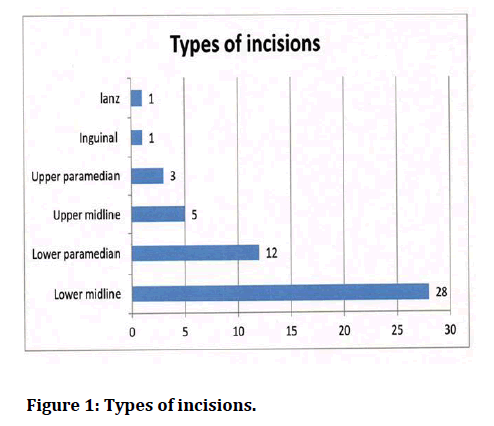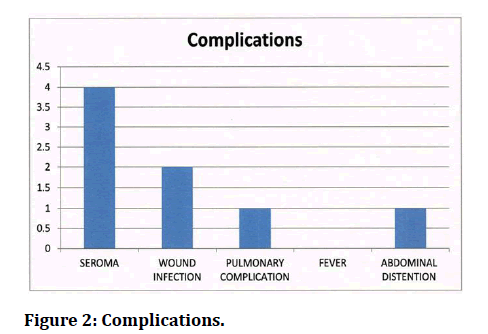Research - (2021) Volume 9, Issue 7
Incisional Hernia-A Comprehensive Study of Patients Admitted in Sree Balaji Medical College Hospital
Audipudi Venkata Ajit and Gopalsamy Santhanam Prabudoss*
*Correspondence: Gopalsamy Santhanam Prabudoss, India,
Abstract
Incisional Hernia is a condition that appears on the layers of the abdominal walls wherein already some incisions are made and are undesirable sequel of surgery which is an iatrogenic problem. Though the overall incidence of incisional hernia is just 9.9% it a very significantly reported in case of midline incisions than transverse incisions. The abdominal walls are very complexly arranged, layered with segmentally The abdominal wall is an anatomically complex, layered structure with segmentally derived blood supply and innervation.
Keywords
Hernia, Incision, Abdominal wallIntroduction
Incisional hernia is hernia that will appear generally on the walls of the abdomen. When comparing the incidence of the hernial type, middle incision type was more common when compared to the lateral one. Though many advancements in the pre and post-operative care of the surgery are done currently by the surgeons, understanding the mechanism and management of incisional hernia is very important. Hence this study focuses on risk factors, prevention of occurrence and management of incisional hernias. Because of this awareness more consideration is being given to the choice of incision, selection of sutures, techniques of wound closure and factors modifying wound healing [1-5]. This study focuses on risk factors, prevention of occurrence and management of incisional hernias.Materials and Methods
Study design
Patients reported to have incisional hernia were taken for the study. Details of the present surgery, onset of hernia, site of incisional hernia, method of repair, recurrence were studied.
Results
From our study it was observed that incisional hernia was more common in female (92%), age of 40-50, this was high due to caesarean sections at younger ages. Also, emergency cases were also the reason.
The predisposing factors were prolonged hospital stay, pulmonary infections, cough breathlessness.
It was also observed that the onset time was within six months of previous surgery (56%). the different type of incision is depicted in Figure 1 below.

Figure 1: Types of incisions.
It was also found that mesh method of repair system was predominantly being done and only 18% of the patients developed post-operative complaints (Figure 2).

Figure 2: Complications.
Discussion
From this study it was found that the main reason for the condition is due to sterilization surgeries and 9 on 50 patients were obese as compared to a previous study confirming the more prevalence in obese patients. Lower midline incision was more common when compared to the other type. The choice of repair mechanism was depending mainly on the size of the hernia and general condition. In fact, many did well after the surgery. More care is needed during emergency surgical procedures to avoid incisional hernia Though its preventable [6-11].
Funding
No funding sources.
Ethical Approval
The study was approved by the Institutional Ethics Committee.
Conflict of Interest
The authors declare no conflict of interest.
Acknowledegements
The encouragement and support from Bharath Institute of Higher Education and Research, Chennai, is gratefully acknowledged. For provided the laboratory facilities to carry out the research work.
References
- Luijendijk RW, Hop WC, Van Den Tol MP, et al. A comparison of suture repair with mesh repair for incisional hernia. New England J Med 2000; 343:392-8.
- Wong SY. Kingsnorth.prevention and surgical management of incisional hernia. Int J Sur Invest 2001; 3:407-14.
- Abrahamson J, Eldar S. Shoelace” repair of large postoperative ventral abdominal hernias: A simple extraperitoneal technique. Contemp Surg 1988; 32:24-34.
- Stadelmann WK, Digenis AG, Tobin GR. Physiology and healing dynamics of chronic cutaneous wounds. Am J Surg 1998; 176:26S-38S.
- Hoer J, Anurov M, Titkova S, et al. Influence of suture material and suture technique on collagen fibril diameters in midline laparotomies. Eur Surg Res 2000; 32:359-67.
- Birk DE, Mayne R. Localization of collagen types I, III and V during tendon development. Changes in collagen types I and III are correlated with changes in fibril diameter. Eur J Cell Biol 1997; 72:352.
- Klinge U, Si ZY, Zheng H, et al. Collagen I/III and matrix metalloproteinases (MMP) 1 and 13 in the fascia of patients with incisional hernias. J Invest Surg 2001; 14:47-54.
- Sorensen LT, Hemmingsen UB, Kirkeby LT, et al. Smoking is a risk factor for incisional hernia. Arch Surg 2005; 140:119-23.
- Sorensen LT, Friis E, Jorgensen T, al. Smoking is a risk factor for recurrence of groin hernia. World J Surg 2002; 26:397-400.
- Schumpelick V, Junge K, Rosch R, et al. Retromuscular mesh repair for ventral incision hernia in Germany. Chirurg 2002; 73:888-94.
- Burger JW, Luijendijk RW, Hop WC, et al. Long-term follow-up of a randomized controlled trial of suture versus mesh repair of incisional hernia. Annals Surg 2004; 240:578.
Author Info
Audipudi Venkata Ajit and Gopalsamy Santhanam Prabudoss*
1IndiaCitation: Audipudi Venkata Ajit, Gopalsamy Santhanam Prabudoss, Incisional Hernia-A Comprehensive Study of Patients Admitted in Sree Balaji Medical College Hospital, J Res Med Dent Sci, 2021, 9(7): 292-293
Received: 07-Jul-2021 Accepted: 22-Jul-2021
